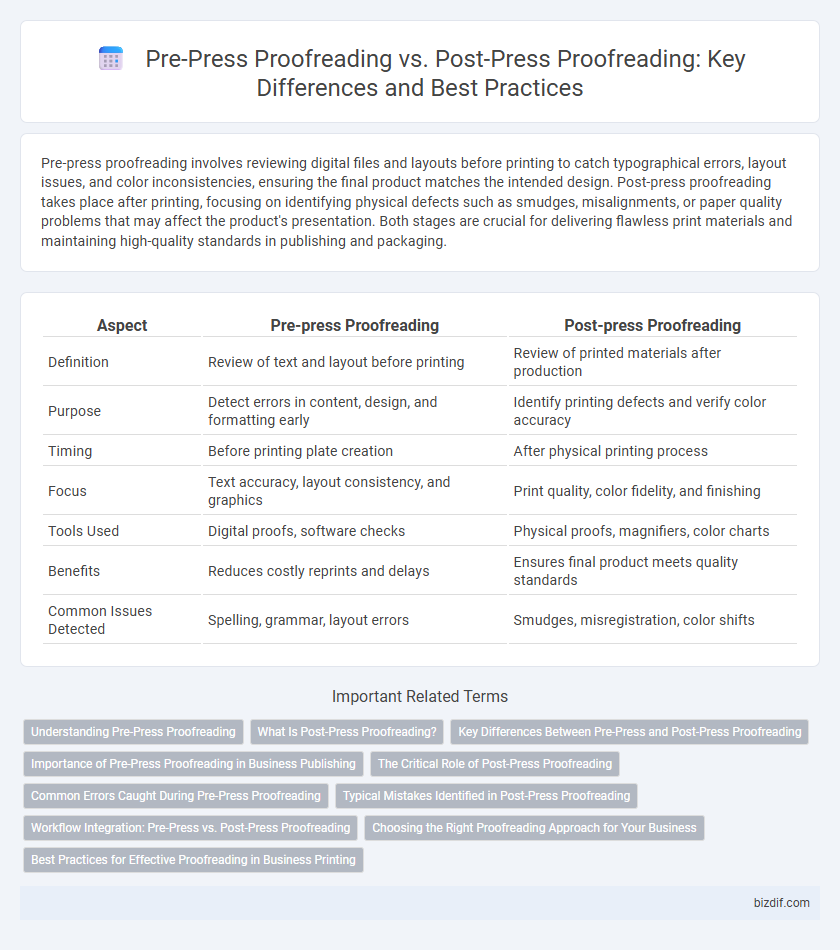Pre-press proofreading involves reviewing digital files and layouts before printing to catch typographical errors, layout issues, and color inconsistencies, ensuring the final product matches the intended design. Post-press proofreading takes place after printing, focusing on identifying physical defects such as smudges, misalignments, or paper quality problems that may affect the product's presentation. Both stages are crucial for delivering flawless print materials and maintaining high-quality standards in publishing and packaging.
Table of Comparison
| Aspect | Pre-press Proofreading | Post-press Proofreading |
|---|---|---|
| Definition | Review of text and layout before printing | Review of printed materials after production |
| Purpose | Detect errors in content, design, and formatting early | Identify printing defects and verify color accuracy |
| Timing | Before printing plate creation | After physical printing process |
| Focus | Text accuracy, layout consistency, and graphics | Print quality, color fidelity, and finishing |
| Tools Used | Digital proofs, software checks | Physical proofs, magnifiers, color charts |
| Benefits | Reduces costly reprints and delays | Ensures final product meets quality standards |
| Common Issues Detected | Spelling, grammar, layout errors | Smudges, misregistration, color shifts |
Understanding Pre-Press Proofreading
Pre-press proofreading involves carefully reviewing digital and printed proofs before the printing process to catch errors in text, layout, and color accuracy. This stage ensures that content aligns with design specifications and prevents costly mistakes during mass production. Understanding pre-press proofreading is essential for maintaining quality control and achieving precise final output.
What Is Post-Press Proofreading?
Post-press proofreading refers to the review process conducted after printing and binding to identify errors that may have been missed during pre-press checks. This stage ensures that the final physical product, including color accuracy, layout, and text integrity, meets quality standards before distribution. Detecting mistakes post-press helps prevent costly reprints and maintains brand reputation by delivering flawless printed materials.
Key Differences Between Pre-Press and Post-Press Proofreading
Pre-press proofreading involves reviewing digital files and proofs before printing to catch errors in layout, text, and color accuracy, ensuring the final product matches the intended design. Post-press proofreading occurs after printing, focusing on identifying defects like ink smudges, paper wrinkles, or binding issues that affect the physical quality of the printed material. The key difference lies in their timing and scope: pre-press proofreading targets digital accuracy and content correctness, while post-press proofreading addresses physical imperfections and finishing errors.
Importance of Pre-Press Proofreading in Business Publishing
Pre-press proofreading is crucial in business publishing as it ensures the accuracy and clarity of text before printing, preventing costly errors and reprints. Detecting mistakes early in the pre-press stage saves both time and resources by addressing typographical, grammatical, and layout issues before final production. This proactive approach maintains brand professionalism and enhances the overall quality of printed business materials.
The Critical Role of Post-Press Proofreading
Post-press proofreading plays a critical role in ensuring the accuracy and quality of the final printed product, catching errors that pre-press proofreading may overlook, such as color inconsistencies, alignment issues, and physical defects. This stage verifies that the print matches the approved proofs and maintains brand integrity, preventing costly reprints and customer dissatisfaction. Effective post-press proofreading safeguards the overall production value, confirming the final output meets the highest standards before distribution.
Common Errors Caught During Pre-Press Proofreading
Pre-press proofreading primarily identifies typographical errors, incorrect fonts, color mismatches, and layout inconsistencies before printing begins, ensuring design accuracy and text clarity. It also catches issues such as missing images, incorrect bleeds, and file resolution problems that could compromise print quality. By addressing these errors early, pre-press proofreading prevents costly reprints and maintains brand integrity.
Typical Mistakes Identified in Post-Press Proofreading
Post-press proofreading commonly identifies typical mistakes such as color mismatches, registration errors, and trimming inaccuracies, which are often overlooked during pre-press checks. It also detects issues like smudges, ink inconsistencies, and binding errors that only become apparent after the printing and finishing processes. These errors affect the final product's visual quality and require correction to ensure brand consistency and print integrity.
Workflow Integration: Pre-Press vs. Post-Press Proofreading
Pre-press proofreading integrates into the workflow before printing, enabling early detection of typographical errors, layout issues, and color inconsistencies, which reduces costly reprints and production delays. Post-press proofreading occurs after printing, focusing on identifying defects such as ink smudges, paper misalignment, and physical damages that were not detectable in the digital phase. This sequential workflow ensures comprehensive quality control by addressing both digital content accuracy and physical print fidelity.
Choosing the Right Proofreading Approach for Your Business
Selecting the appropriate proofreading approach depends on the specific needs of your business, with pre-press proofreading targeting textual accuracy before printing to minimize costly errors, while post-press proofreading ensures quality control by verifying the final printed material. Businesses focusing on brand consistency and error-free content often prioritize pre-press proofreading to catch mistakes early, whereas companies emphasizing product quality and physical inspection benefit from post-press proofreading. Evaluating workflow efficiency, production timelines, and error tolerance helps determine whether pre-press or post-press proofreading aligns best with your operational goals.
Best Practices for Effective Proofreading in Business Printing
Pre-press proofreading focuses on catching errors before printing, ensuring text accuracy, layout consistency, and color correctness to avoid costly reprints. Post-press proofreading involves inspecting the final printed material for defects such as smudges, alignment issues, and color deviations to guarantee quality standards. Implementing a dual-stage proofreading process with standardized checklists and qualified proofreaders enhances accuracy, reduces waste, and ensures professional business printing outputs.
Pre-press proofreading vs Post-press proofreading Infographic

 bizdif.com
bizdif.com